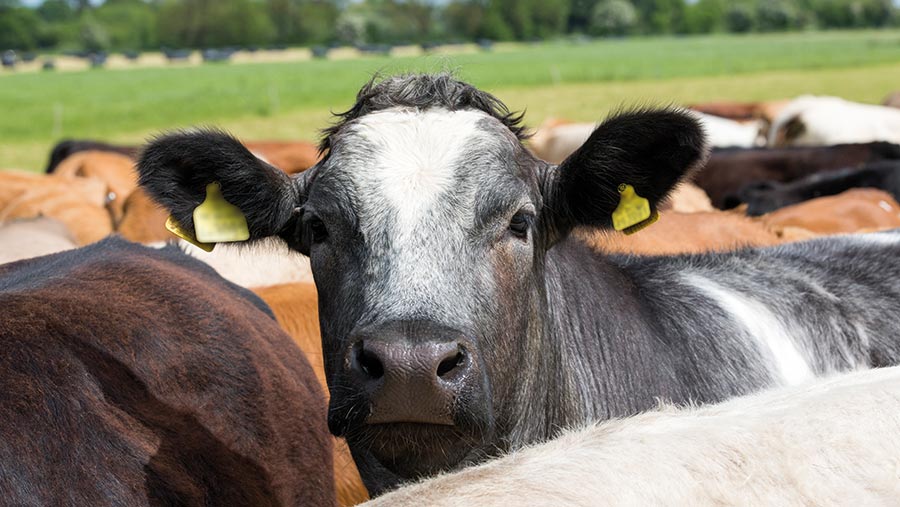Redwater fever in cattle: What it is and how to manage it
 © GNP
© GNP Redwater fever is the colloquial name for bovine babesiosis, a disease of cattle.
In the UK, redwater is caused by two species of protozoan parasite: Babesia divergens and Babesia major.
B divergens is by far the more common of the two and is also more prone to causing severe disease.
See also: Vaccination for beef suckler cow diseases: Why, when and how
Transmission
In the UK, Babesia is transmitted by the hard tick Ixodes ricinus. Once injected into the bloodstream by the tick, the parasite invades red blood cells and begins dividing, eventually rupturing the cells.
Clinical signs begin about two weeks after infection.
Ticks can also pass Babesia transovarially (from adult to egg to larva).
This has implications for control, as the disease can be maintained between seasons, even if it is removed from host mammals by treatment or avoiding grazing risk areas.
It is thought that Babesia can survive within the tick population for up to four years without any requirement for periods in the cow.
About the author

Paul Doran is a vet at Friars Moor Livestock Health, Dorset. He has a particular interest in farm animal diagnostics and post-mortem investigation.
Each month, we bring practical advice from an XLVets practice on a range of different subjects.
Historically, deer were not thought to be a significant reservoir of infection because studies relying on blood smear examination failed to detect the parasite in them.
However, a more recent PCR-based study, conducted on a farm where the disease was present, showed 11% of red deer on the farmland and surrounding areas were infected with B divergens, suggesting their significance may have been underestimated.
Disease in the UK is seen mainly in South West England, with seasonal peaks in the spring and autumn.
Clinical signs
The most recognisable clinical sign is red urine. The colour comes from haemoglobin produced by the rupture of red blood cells.
Other clinical signs include high temperature (often 40C or more), anorexia, depression, weakness, high heart rate and “pipe stem diarrhoea”. These progress to severe dehydration, recumbency and sometimes death.
Diagnosis is based on history, clinical signs, confirmation of anaemia and examination of stained blood smears.
PCR testing is available and is more sensitive than blood smear examination, but is considerably more expensive and not suitable for rapid cow-side diagnosis.
Milder cases of redwater can recover without treatment.
It has been shown that clinical signs do not occur in every incidence of adult infection, so it is likely that a significant proportion of infections may pass unnoticed.
Factors thought to affect the outcome of an infection include the age of the animal, number of infecting ticks, virulence of the B divergens strain, any factor that may cause immunosuppression, and co-infection of cattle with other tick-related ailments such as tick-borne fever or anaplasmosis.
Treatment
The mainstay of treatment for redwater is administration of imidocarb dipropionate. Given the clinical signs, anti-inflammatories are also advised.
Blood transfusion is often necessary in severely anaemic cattle.
A commonly accepted rule of thumb is that animals with a packed cell volume (PCV) of less than 15% are likely to benefit from transfusion, and those with a PCV of 10% or less are highly unlikely to survive without a transfusion.
Immunity
Cattle have an inverse age resistance to babesiosis, which means youngstock are highly resistant to the disease, whereas adults with no previous exposure to infection are not.
Therefore, young animals exposed to the disease can acquire immunity without showing any clinical signs and will maintain this immunity owing to repeated tick challenges.
Cattle in endemic areas will rarely show clinical signs, but non-immune adult cattle brought into an endemic area, or present in an area where tick migration has occurred, may be susceptible.
The age at which susceptibility to disease from Babesia infection increases is unclear.
One review suggested calves up to nine months old were resistant to clinical disease, while another implied that a less complete degree of resistance may prevail up to two-and-a-half years.
Prevention
Imidocarb can be used at a higher dose rate for prevention of clinical disease in naive animals moving to a high-risk area.
This is thought to provide protection for three to six weeks while still allowing natural immunity to occur.
Several vaccines for Babesiosis exist, although none is licensed in the UK. Apparently, all live vaccines have significant drawbacks or limitations.
Exposing youngstock to ticks should ensure natural immunity is acquired, but achieving this might not be practical in all situations. In many cases, Babesia seems to affect particular fields, rather than a whole farm.
While several antibody tests for demonstrating exposure to the parasite have been developed and can be used in research settings, cost and practicality have prevented these tests from becoming commercially available.
Blood smear examination and PCR tests are of little practical value for monitoring exposure, so there is no way to measure the effectiveness of youngstock exposure.
Tick control can be used to reduce the risk of the disease by reducing the degree of challenge.
Neither synthetic pyrethroids nor macrocyclic lactones have a licence for tick control in UK cattle, although certain preparations may be prescribed for tick control by your vet.
However, tick control could potentially be a double-edged sword in that it may compromise the development of natural immunity in younger animals.
This raises the risk of outbreaks when these animals mature.
There is a further potential risk when macrocyclic lactones are used as part of a worm control programme, as tick control may then occur as an unintended side effect.
